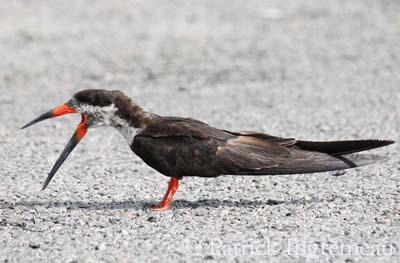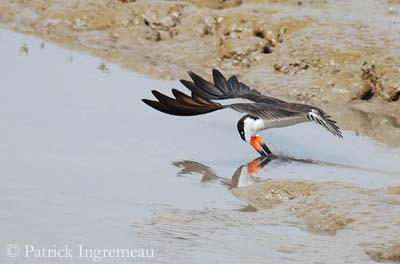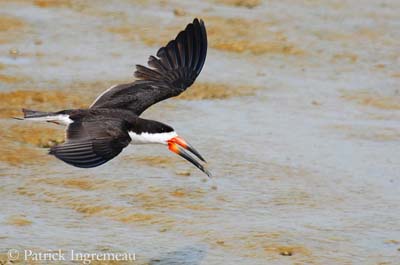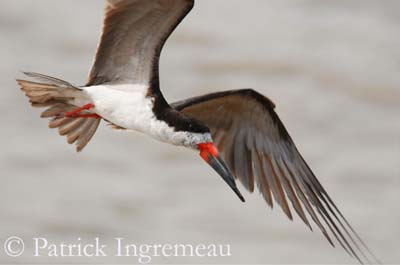
Black Skimmer
Rynchops niger
Charadriiforme Order - Laridae Family
BIOMETRICS:
Length: 46 cm ; Wingspan: 112 cm ; Weight: M :350g – F : 255g
LONGEVITY: up to 20 years
DESCRIPTION:
Black skimmer has a remarkable bill, with base bright orange-red and black tip. Flexible lower mandible is flattened and longer than the upper, about 1/3 more. Upper mandible is rounded, leaving a space between both.
It is the unique bird having vertical pupil, allowing it to reduce them as a simple chap when in front of the sun, or to open as a circle with weak light.
Black skimmer has black cap and mantle, contrasting strongly with white underparts and forehead. Upperwings are black, with fine white edge. Underwings are pale. Wings are very long.
Legs are orange-red and short. Feet are orange-red and webbed. It has short white tail with black centre feathers. Tail is square or slightly forked.
Eyes are dark brown.
Both sexes are similar, with male slightly larger than female, and with longer bill.
Juvenile is similar to adult, with mottled black and white back and head.

VOICE: SOUNDS BY XENO-CANTO
Black skimmer’s call is a barking “yip”. When it is threatened, it takes off, uttering harsh cries. When they feed together, they give their “hurk-hurk-hurk” repeated twice or thrice at short intervals. These birds become noisy as the darkness comes.
HABITAT:
Black skimmer inhabits in coastal marshes, and in sandy shores, shallow bays, inlets and estuaries. Typical roosted areas are situated on public beaches, with human activity, or estuarine sand bars with shorebirds, gulls and terns.
RANGE:
Black skimmer lives in southern North America, Caribbean and South America. It breeds in North and South America. Northern birds winter in Caribbean and South American birds make some short movements to feed.
BEHAVIOUR:
Black skimmer feeds by skimming the surface of the water, with its specific bill. They feed in large flocks.
Black skimmer flies low over the water, the lower mandible skimming the surface for small fishes and crustaceans. When it catches a prey, it bows the head and closes its bill. Then, it bends its beak below the body before to rise higher to turn its prey and swallow it in flight.
When it is skimming, its lower mandible makes an angle of almost 45 degrees with the upper, which is elevated a little above the surface. They feed mainly under low wind, when the surface is quiet.

It feeds especially from dusk to dawn because it is highly nocturnal. It spends the whole night on wing, searching for food.
Black skimmer performs flight displays. Several excited males may pursue a female. They fly hither and thither, upwards and downwards, and in all directions, while they utter their love-calls with vehemence, a soft and tender “ha-ha”, or at the end of the chase, their “hack-hack-hack-cae-cae”. Male extends its wings for an instant, and struts by the side of female.
Black skimmer doesn’t like Crows and Buzzards on their breeding grounds. When these birds appear, about a dozen or more of Black skimmers at once, give chase to them until quite out of sight.
FLIGHT:
Black skimmer has a light and elegant flight, with steady beats. When they fly in large flocks, their aerial evolutions are wonderful, suddenly rounding to, and passing, flying so close together as to appear like a black cloud, ascending and rushing down together.

REPRODUCTION:
Black skimmer’s nest is only a shallow depression in the sand. Black skimmer breeds on beaches, in loose colonies. They turn in the scrape to create a cup-shaped depression, where no materials are added. During nest building, pair makes turns scraping, with exaggerated posture, neck, head, bill and tail erected, with alternate foot strokes that eject sand backwards. Nest building needs 5 to 7 days.
Female lays 4 to 5 white eggs, largely blotched with black and with some purplish brown spots. Incubation lasts about 21 to 23 days, or 25 days if disturbed. Incubation is only by female.
Young appear on the same colour as the sand, and they are not able to fly before 6 weeks, but they fledge at 23 to 25 days. At hatching, chicks have their mandibles equal in length.
Both parents feed them by regurgitation, and at the end, they pick up shrimps, prawns, small crabs and fishes dropped before them.
Young reach their sexual maturity at 2 years old.
When they are gorged and tired, both, parents and young, lie flat on the sand, with their bills extended before them.

DIET:
Black skimmer feeds mainly on small fishes, between 1, 20 to 4, 70 inches, and also crustaceans.
PROTECTION / THREATS / STATUS:
Black skimmer populations are threatened by human disturbances at nesting sites, predation by dogs and feral cats, and loss of suitable nesting areas.
Fr: Bec en ciseaux noir
All : Amerikanischer Scherenschnabel
Esp : Rayador Americano
Ital: Becco a cesoie americano
Nd: Amerikaanse Schaarbek
Sd: Amerikansk saxnäbb
Photographs by Patrick Ingremeau
TAMANDUA
Text by Nicole Bouglouan
Sources :
HANDBOOK OF THE BIRDS OF THE WORLD Vol. 3 by Josep del Hoyo-Andrew Elliott-Jordi Sargatal - Lynx Edicions - ISBN: 8487334202
Wikipedia (Wikipedia, The Free Encyclopedia)
Animal Diversity Web (University of Michigan Museum of Zoology)
All About Birds (Cornell Lab of Ornithology)
What Bird-The ultimate Bird Guide (Mitchell Waite)